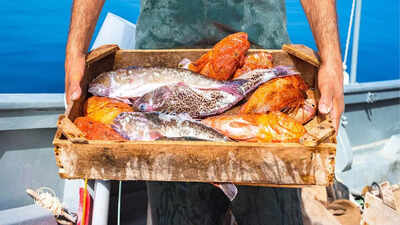ARTICLE AD BOX

Every year, wild and farmed fish are killed in great numbers to feed humanity. A new study discovers that some of the fish suffer between two to twenty minutes of intense pain, once they are killed for food. Even stuffing fish in ice slurry after catching them could cause severe pain.According to earth.com, the researchers found that rainbow trout- a species of fish consumed across the globe- experience around 10 minutes of moderate to intense pain when killed through ‘air asphyxiation’, a common method used in fish farming and commercial farming. A new study led by researchers sheds light on this pain and suggests ways to reduce it, as
animal welfare
groups state that it is an inhumane process, given the amount of time it takes for them to lose consciousness.
Fish suffer for long minutes of pain after being caught
When fish are pulled out of water, they experience a prolonged and stressful decline, lasting up to 24 minutes. The process of air asphyxiation involves removing the fish from water, leading to oxygen deprivation, panic, and a slow decline into unconsciousness. Their gills collapse, they gasp in panic, their blood chemistry spirals, and oxygen disappears as carbon dioxide builds.
To quantify this suffering, scientists developed the Welfare Footprint Framework, which measures pain in minutes. Applying this framework to trout slaughter, researchers found that fish endure about 10 minutes of severe pain, including hurtful and disabling suffering,with some cases extending beyond 20 minutes. When adjusted by weight, that translates to 24 minutes of such pain per kilogram of fish killed. The researchers analyzed behavioral, neurological, and physiological responses to understand the fish’s experience, highlighting the need for more human slaughter methods.
Why fish suffer even before they’re killed
The suffering of fish often begins before the actual slaughter, with stressors like crowding, transport, and handling causing physical injury and hours of distress. Methods like air asphyxiation and ice exposure can prolong suffering, with the latter risking tissue damage and thermal shock. Regulations often overlook these pre-slaughter stressors, despite the significant impact on fish welfare.
Fish slaughter pain is not limited to Trout, experts warn
Although the study mainly focused on Rainbow trout, other species may suffer in similar ways during air exposure. Some species tolerate low oxygen better, while others may react more strongly to ice. Salmon, Catfish, Seabass, and Tilapia are a few of the species. Dr. Wladimir Alonso from Welfare Footprint Institute noted, “The Welfare Footprint Framework provides a rigorous and transparent evidence-based approach to measuring animal welfare, and enables informed decisions about where to allocate resources for the greatest impact.”
Making fish farming more humane
The study suggests that improved stunning methods and worker training can significantly reduce
fish suffering
. This research provides a scientific basis for policymakers to reform laws, ensuring more humane slaughter practices. For consumers, it highlights the importance of considering the welfare of fish when making food choices. Improving slaughter methods can have a substantial impact, given the large number of fish affectedAlso read | Scientists spot ‘superorganism’ in the wild for the first time — and it’s made of worms



.png)
.png)
.png)
















 10 hours ago
5
10 hours ago
5









 English (US) ·
English (US) ·